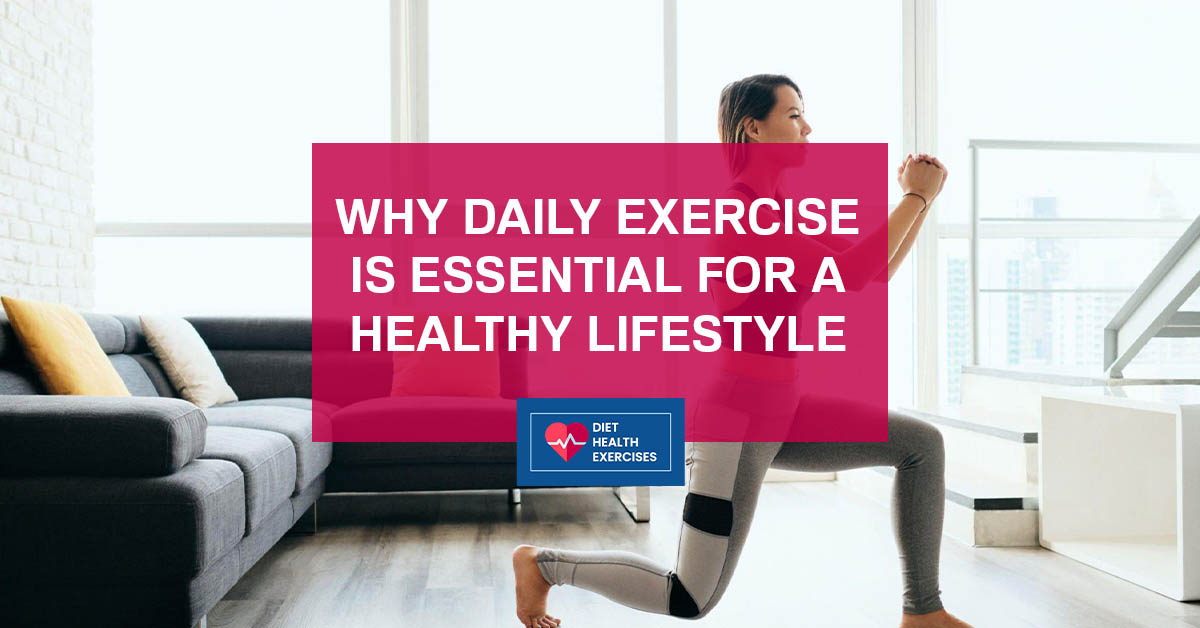In today’s fast-paced world, it’s easy to get caught up in the hustle and bustle of everyday life and neglect our physical health. However, daily exercise is essential for a healthy lifestyle and should be a top priority for everyone. Not only does regular physical activity help to maintain a healthy weight and prevent chronic diseases, but it also improves our mental health and overall well-being. From reducing stress and anxiety to boosting our energy levels and improving our sleep quality, the benefits of exercise are endless. So if you’re looking to improve your health and well-being, it’s time to get moving! In this article, we’ll explore the top reasons why daily exercise is essential for a healthy lifestyle, and provide you with some tips on how to incorporate physical activity into your daily routine.
Table of Contents
ToggleThe importance of daily exercise for overall health

Daily exercise is essential for maintaining good health and preventing chronic diseases. It is recommended that adults get at least 150 minutes of moderate-intensity aerobic exercise per week, or 75 minutes of vigorous-intensity aerobic exercise per week, along with muscle-strengthening activities at least two days per week. Regular physical activity has been shown to reduce the risk of developing conditions such as heart disease, stroke, type 2 diabetes, and certain types of cancer. It can also help to lower blood pressure and cholesterol levels, as well as improve bone density and joint health.
Exercise is also important for maintaining a healthy weight. When we engage in physical activity, we burn calories and increase our metabolism, which can help us to lose weight or maintain a healthy weight. Regular exercise can also help to reduce visceral fat, which is a type of fat that accumulates around the organs and is associated with an increased risk of chronic diseases.
Physical benefits of regular exercise
Regular exercise provides numerous physical benefits, including improved cardiovascular health, increased muscle strength and endurance, and better flexibility and balance. Cardiovascular exercises, such as running, cycling, or swimming, can improve heart health and help to reduce the risk of developing heart disease. Strength training exercises, such as lifting weights, can help to increase muscle mass and bone density, as well as improve overall strength and endurance. Flexibility exercises, such as stretching or yoga, can improve the range of motion and reduce the risk of injury.
Exercise also helps to improve our immune system, making us less susceptible to illness and disease. It stimulates the production of white blood cells, which are responsible for fighting off infections and diseases. Additionally, exercise helps to improve circulation, allowing nutrients and oxygen to be delivered to the cells more efficiently.
Mental benefits of regular exercise

Exercise is not just beneficial for our physical health, but it also has numerous mental health benefits. Regular physical activity has been shown to reduce symptoms of anxiety and depression, improve mood and self-esteem, and reduce stress levels. Exercise releases endorphins, which are natural chemicals that help to elevate our mood and reduce feelings of pain and stress. It also helps to increase the production of neurotransmitters such as serotonin and dopamine, which are associated with feelings of happiness and well-being.
Exercise can also improve cognitive function and brain health. It has been shown to improve memory, attention, and concentration, as well as reduce the risk of developing cognitive decline or dementia later in life. Regular exercise can also improve sleep quality, which is essential for overall health and well-being.
How much exercise do you need?
The amount of exercise you need depends on your individual goals and fitness level. The American Heart Association recommends at least 150 minutes of moderate-intensity aerobic exercise per week for adults, along with muscle-strengthening activities at least two days per week. However, if you are looking to lose weight or build muscle, you may need to increase your exercise frequency and intensity.
Are you struggling to lose belly fat, despite your best efforts? High levels of cortisol, the “stress hormone,” can make it difficult to shed those extra pounds. But don’t worry – we can help! Our page offers tips and strategies for reducing cortisol levels and shrinking belly fat. From stress management techniques to diet and exercise recommendations, we’ve got you covered. So why wait? Visit our page now to learn how to reduce cortisol and start seeing results!
It’s important to start with a realistic goal and gradually increase your exercise routine over time. If you are new to exercise, start with 10-15 minutes of moderate-intensity exercise per day and gradually increase to 30-60 minutes per day. You can also break up your exercise routine into smaller increments throughout the day, such as three 10-minute sessions.
Tips for incorporating exercise into your daily routine
Incorporating exercise into your daily routine can be challenging, but it’s essential for a healthy lifestyle. Here are some tips to help you get started:
- Find an activity you enjoy: Choose an exercise that you enjoy and look forward to doing. This can be anything from walking to dancing to swimming.
- Make it a priority: Schedule exercise into your daily routine and treat it like any other appointment.
- Start small: Begin with a manageable amount of exercise and gradually increase over time.
- Mix it up: Try different types of exercise to keep your routine interesting and challenging.
- Make it social: Exercise with a friend or join a group fitness class for added motivation and accountability.
Common excuses for not exercising and how to overcome them

There are many common excuses for not exercising, such as lack of time, lack of motivation, or feeling too tired. However, these excuses can be overcome with a little creativity and determination. Here are some tips to help you overcome common exercise excuses:
- Lack of time: Incorporate exercise into your daily routine by walking or biking to work, taking the stairs instead of the elevator, or doing a quick workout during your lunch break.
- Lack of motivation: Find an exercise buddy or hire a personal trainer for added motivation and accountability.
- Feeling too tired: Exercise can actually help to boost energy levels and reduce fatigue. Start with a low-intensity exercise, such as walking or yoga, and gradually increase over time.
Types of exercises to try
There are many different types of exercise to try, depending on your interests and fitness level. Here are some popular types of exercise to consider:
- Aerobic exercise: This includes activities such as walking, running, cycling, or swimming, which increase heart rate and breathing.
- Strength training: This includes exercises such as weight lifting or resistance band workouts, which help to build muscle and improve strength.
- Flexibility exercises: This includes activities such as stretching, yoga, or Pilates, which improve range of motion and reduce the risk of injury.
- High-intensity interval training (HIIT): This involves short bursts of high-intensity exercise followed by periods of rest, which can be effective for burning calories and improving cardiovascular health.
Do you want to take control of your health and nutrition? Our calorie calculator can help! With just a few clicks, you can find out how many calories you need to consume each day to maintain a healthy weight, based on your age, gender, height, weight, and activity level. Whether you want to lose weight, gain muscle, or just maintain a healthy lifestyle, our calculator can help you get there. So why wait? Visit our page today and start calculating your daily calorie needs!
How to make exercise fun and enjoyable
Exercise doesn’t have to be a chore – it can be fun and enjoyable! Here are some tips to make exercise more enjoyable:
- Listen to music: Create a workout playlist with your favorite songs to keep you motivated and energized.
- Try something new: Mix up your routine by trying a new exercise or activity that you’ve never done before.
- Exercise outdoors: Take advantage of the great outdoors by going for a hike, bike ride, or run in your local park or trail.
- Make it a social activity: Exercise with a friend or join a group fitness class for added motivation and accountability.
Tracking progress and staying motivated
![]()
Tracking your progress can help to keep you motivated and on track with your fitness goals. Here are some ways to track your progress:
- Keep a fitness journal: Write down your exercise routine and track your progress over time.
- Use a fitness app: There are many fitness apps available that can help you track your progress, set goals, and stay motivated.
- Take progress photos: Take photos of yourself periodically to see how your body is changing over time.
- Celebrate milestones: Celebrate your achievements along the way, whether it’s running your first 5K or lifting a heavier weight.
Frequently Asked Questions About Health And Exercise
What are the benefits of regular exercise?
You can benefit greatly from regular exercise for both your physical and emotional wellbeing. It can support better sleep, enhance your mood, increase your energy levels, help you maintain a healthy weight, lower your chance of developing chronic illnesses like diabetes and heart disease, and more.
How frequently should I work out?
At least 150 minutes of moderate-intensity aerobic activity or 75 minutes of vigorous-intensity aerobic exercise should be performed each week, according to the American Heart Association. Additionally, at least two days a week should be dedicated to weight training.
What are some examples of aerobic exercise?
Running, cycling, swimming, dancing, and participating in sports like tennis or basketball are all examples of aerobic exercise.
How can I stay motivated to exercise regularly?
Setting precise goals, finding an exercise partner, altering your routine to avoid boredom, and rewarding yourself for hitting milestones are just a few methods to keep motivated to exercise frequently.
Is a warm-up important before working out?
Yes, warming up before exercise is crucial to getting your body ready for the activity and lowering the risk of injury. Stretching, light cardio, and dynamic movements that closely resemble the exercises you’ll be performing can all be included in a warm-up.
Conclusion: Start your journey towards a healthy lifestyle
In conclusion, daily exercise is essential for a healthy lifestyle and should be a top priority for everyone. Regular physical activity has numerous physical and mental health benefits, including reducing the risk of chronic diseases, improving cardiovascular health, reducing stress and anxiety, and improving sleep quality. By incorporating exercise into your daily routine and making it enjoyable, you can improve your overall health and well-being. So get moving and start your journey towards a healthier lifestyle today!


